Libby Fischer Hellmann's Blog, page 14
April 25, 2017
Your Favorite First Line
 You crack open a new book or click on the first page of an ebook. You’re greeted by that all-important first line. Does it make your heart sink or soar? As every author knows, that first sentence gives you the opportunity to hook your readers. Provided you’ve crafted the sentence the reader knows something is going on, and they have to read on to catch up with you. In other words, an author’s must create instant suspense. And the best way to do that is to start in media res, right in the middle of the action. No matter what the genre.
You crack open a new book or click on the first page of an ebook. You’re greeted by that all-important first line. Does it make your heart sink or soar? As every author knows, that first sentence gives you the opportunity to hook your readers. Provided you’ve crafted the sentence the reader knows something is going on, and they have to read on to catch up with you. In other words, an author’s must create instant suspense. And the best way to do that is to start in media res, right in the middle of the action. No matter what the genre.
So…welcome to my first annual Best Ever First Line Contest.
Six of the best…
First, let’s set the scene. Here are six of my all-time favorite first lines.
“The man with ten minutes to live was laughing.” The Fist of God‘ by Frederick Forsyth.
“The small boys came early to the hanging.” Pillars Of The Earth by Ken Follett.
“Some women give birth to murderers, some go to bed with them, and some marry them.” Before The Fact, by Francis Iles (basis for Hitchcock’s Suspicion).
“I turned the Chrysler onto the Florida Turnpike with Rollo Kramer’s headless body in the trunk, and all the time I’m thinking I should have put some plastic down.” Gun Monkeys by Victor Gischler.
“It was a bright cold day in April, and the clocks were striking thirteen.” 1984 by George Orwell.
“Scarlett O’Hara was not beautiful, but men seldom realized it when caught by her charm as the Tarleton twins were.” Gone With the Wind by Margaret Mitchell
You get the picture. So how’s it done?
Three ways to blow someone’s mind
There are three elements a writer can use to grab someone by the throat from line one: exposition, narrative and dialogue. An exposition might go something like this:
From my novel A Picture of Guilt: “The raft plunged straight down and slammed into  a wall of water.”
a wall of water.”
A narrative-based introduction can also be powerful, for example the first sentence of Easy Innocence: “Long after she moved on, she would remember the smells.”
And then there’s dialogue. How about this, from A Shot To Die For: “What do you mean you’re not coming? You were supposed to meet me! We had a date!”
No matter which element you choose, the idea is to make the scene so clear and compelling that the reader must find out more: why did the raft plunge down a wall of water? What smells was she talking about? Why was the date broken? If you don’t turn the page, you’ll never know.
Making suspense fun
A gripping first sentence doesn’t mean you have to sacrifice humor. (See Victor Gischler’s first line above)
How about this, from Freezer Burn by Joe Lansdale? “Bill Roberts decided to rob the firecracker stand on account he didn’t have a job and not a nickel’s worth of money and his mother was dead and kind of freeze-dried in her bedroom.”
Could you close that book and walk away after reading the first sentence? I couldn’t. The same goes for this one, from Fat Tuesday, by Earl Emerson:
“I was trapped in a house with a lawyer, a bare-breasted woman, and a dead man. The rattlesnake in the paper sack only complicated matters.”
And this, from Dead Over Heels, by Charlaine Harris:
“My bodyguard was mowing the yard wearing her pink bikini when the man fell from the sky.” Just brilliant, don’t you think?
Your turn
Whether you’re a writer or a reader, or both, I’d love to know what you think. What’s your favorite Best Ever First Line? Please leave a comment below with the line itself and the book it comes from, and I’ll pick out the best. Winner gets whatever book of mine you want in ebook or audio. You in?
The post Your Favorite First Line appeared first on .
April 1, 2017
The Ghost Village of Tyneham, UK
 They call it the Ghost Village.
They call it the Ghost Village.
World War Two caused tremendous disruption in Britain—a kind we didn’t see in the States. Several ancient villages were used by the army as training zones for target practice. They included Balsdean in East Sussex, which had a Norman church dating back to the 11th century and was bombed out of existence. Imber, on Salisbury Plain in Wiltshire, is another village left empty in 1943. And the villagers at Langford, Stanford, Sturston and Tottington, all in Norfolk, left in 1942 and never returned.
Then there is Tyneham, which lies in Dorset near the English Channel. It too was abandoned during the War. I visited the place on my recent visit to the UK. The Allied Forces needed to use the village and some neighboring tiny hamlets to train for D-Day landings, so the British military evacuated the 250 villagers. It was supposed to be a temporary measure, just for the duration of the war. However, the villagers never returned, and now the village lies in ruins. Here is Tyneham’s story.
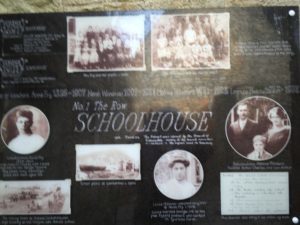 Tyneham’s roots date back to the Roman occupation and even further to the Iron Age, when it was a thriving fishing community. It grew into a charming village, with a church, a school, and small homes surrounding a manor house which once belonged to the Bond family. Today Tyneham, set in the middle of the Lulworth Military Range, is still inaccessible when the firing range is active. The ground around it is still studded with unexploded ordnance. As you can imagine, I stuck to the footpaths.
Tyneham’s roots date back to the Roman occupation and even further to the Iron Age, when it was a thriving fishing community. It grew into a charming village, with a church, a school, and small homes surrounding a manor house which once belonged to the Bond family. Today Tyneham, set in the middle of the Lulworth Military Range, is still inaccessible when the firing range is active. The ground around it is still studded with unexploded ordnance. As you can imagine, I stuck to the footpaths.
The people of Tyneham were told in 1943 that they had just a month to pack up their lives, gather their belongings and move out of the homes they’d been in for generations. 252 villagers were displaced so shelling practice could take place.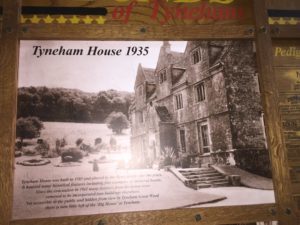
It’s hard to imagine how the villagers felt having to leave a village that had been in constant occupation since the 1300s. A note left by one young girl, 17 year old Helen Taylor, who lived there said it all: “Please treat the church and houses with care. We have given up our homes, where many of us have lived for generations, to help win the war to keep men free. We will return one day and thank you for treating the village kindly.”
Indeed, most of the villagers packed up and left in December 1943, convinced they’d be back once the fighting stopped. But 1952 saw a compulsory purchase order put on the land, and it is still in use as part of the military training base. And in 1967 the Ministry of Works pulled down the beautiful Elizabethan manor house.
 These days the pretty gray-stoned buildings are mostly gone or in ruins. Walls and rooves have toppled, but the quaint 13th century village church has been remodeled. The village’s old red cast iron phone box still contains a note from those far-off days, saying, “I am on war work. If you must use me be brief.”
These days the pretty gray-stoned buildings are mostly gone or in ruins. Walls and rooves have toppled, but the quaint 13th century village church has been remodeled. The village’s old red cast iron phone box still contains a note from those far-off days, saying, “I am on war work. If you must use me be brief.”
Remarkably, Helen Taylor is still alive, now aged 92, and she doesn’t bear any grudges. As she said in a recent interview with the UK’s Sun newspaper, “We went with goodwill, thinking we were doing our share to help with the war.”
I was fortunate to be able to visit, since Tyneham is only accessible when the Lulworth Ranges are open to the public.
There are more than 3000 abandoned settlements in England, many deserted during the terrifying Bubonic Plague years in the 1600s, but Tyneham is the only English village evacuated by the army to serve the needs of a nation at war. The US has plenty of ghost towns too, of course, deserted when factories closed, mines ran dry, or the gold rush ended. 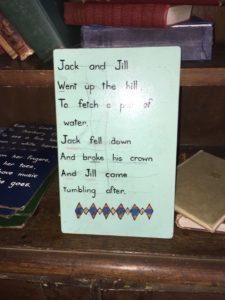 But there’s an added poignancy to Tyneham, whose residents fully expected to return to their beloved homes.
But there’s an added poignancy to Tyneham, whose residents fully expected to return to their beloved homes.
You can find out more about the village and watch a video on the official website.
The post The Ghost Village of Tyneham, UK appeared first on .
March 24, 2017
Domestic Noir and Femme Fatales
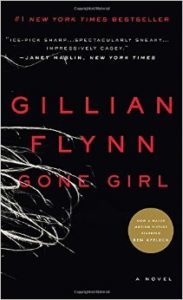 It started with GONE GIRL by Gilliam Flynn. The book took a while to take off, but when it did, it flew to the top of the bestseller charts and stayed there over a year. It also launched a new subgenre of crime fiction, which began to be called “Domestic Noir.” Btw, I hate that term. Not the book – I loved GONE GIRL. What I hate is the name of the subgenre. Because the trend is not really “cozies gone crazy;” the accurate way to describe GONE GIRL is that it features two unreliable narrators.
It started with GONE GIRL by Gilliam Flynn. The book took a while to take off, but when it did, it flew to the top of the bestseller charts and stayed there over a year. It also launched a new subgenre of crime fiction, which began to be called “Domestic Noir.” Btw, I hate that term. Not the book – I loved GONE GIRL. What I hate is the name of the subgenre. Because the trend is not really “cozies gone crazy;” the accurate way to describe GONE GIRL is that it features two unreliable narrators.
An unreliable narrator is someone whose credibility has been seriously compromised, a term that first arose in 1961 in literary critic Wayne C. Booth’s book, The Rhetoric of Fiction. It’s a valuable tool for writers, who can either make that unreliability obvious from the start, reveal it gradually or use it as a major plot twist in some other way. The character might be unreliable because they’re crazy, lying, deluded, all sorts of reasons. Whatever the reason, it’s supposed to lend a thrilling extra edge to a plot.
And it did. With both Perfect Amy and her husband telling us their story from their own point of view, we get a skewed picture of their marriage, and it’s left to us to put the pieces together. Moreover, what one reader might conclude from the story may have been quite different from another reader’s. In that sense, GONE GIRL was truly remarkable.
After its meteoric success I suppose we should have expected copy-cat stories— publishers are always looking for the next bright shiny object—and we got unreliable narrators in spades. First there was The Girl On The Train, which brashly compared itself to GONE GIRL and was very successful because of it (although the movie based on it was almost unwatchable) We’ve also seen a flurry of novels with the word “Girl” in the title. The Girl Who Chased The Moon. Girl at War. The Good Girl. Luckiest Girl Alive. The Girls. Razor Girl. Brown Girl Dreaming. In fact, Canadian novelist Emily St John Mandel looked into the growing trend and found that almost 1% of ALL fiction published in 2016 had ‘girl’ or ‘girls’ in the title.
Call me picky, but the ‘girls’ in these books are mostly women. Not girls. And that in itself is disturbing. The unreliable narrator, a grown woman, is reduced to girl-size by her creators, many of whom are female themselves. Of course, men write ‘girl’ books, too. But in their case, also noted by Emily St John Mandel, more of those end up dead.
The best of the ‘girl’ novels feature a narrator whose unreliability is fascinating, believable, human, potent. In the worst, the women’s unreliability can be as shallow as having bad hair and bitten fingernails. Flynn’s Amy appears strong, definite, albeit a psychopath, which made her compelling. But many of her unreliable sisters in other ‘girl’ books are not.
Then there’s the timing of the whole domestic noir thing. Is it more than coincidence that in our post-truth world, some people are promoting the idea that women are second class citizens, not worthy of respect, mere feeble sex objects? Or is it just the way the publishing cookie happens to crumble?
Many of the women in these domestic noir novels are far from strong, far from independent, far from free-thinking. They are frequently weak, confused, overly dependent on men, unable to see the wood for the trees, trapped, about as far from strong female villains as it gets. Paula Hawkins’ Rachel Watson is pathetic, damaged, passive, easily fooled, and lacks confidence, a drip. She’s no heroine. We have spent years vilifying female villains in novels, but at least they had some oomph, some power, some influence, some strength. They were “femme fatales.” But domestic noir vilify seems to portray females differently. We seem to have replaced the femme fatale with contemporary female protagonists that are helpless, less influential.
Journalist Eva Wiseman has a different take on the ‘girl’ thing. As she says in a column in the UK’s Guardian she believes one thing these novels share is that they “seemed initially to use the suggestion of a sweet and vulnerable object to titillate… But the more I read … the more I understood why… The girl is a “girl” not because she’s weak, but because she is on the verge of changing into something else. She’s not simply a victim, or a wife. She will be asking questions of her place in the world.”
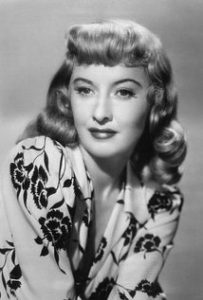 If that’s the case, I wish they would all change fast. I want a strong, courageous female character. She may be evil, she may be dangerous, but I want her reliably so. Like Barbara Stanwyck in Double Indemnity.
If that’s the case, I wish they would all change fast. I want a strong, courageous female character. She may be evil, she may be dangerous, but I want her reliably so. Like Barbara Stanwyck in Double Indemnity.
What about you?
The post Domestic Noir and Femme Fatales appeared first on .
March 12, 2017
My Favorite WW2 Novels
It may have ended more than seventy years ago. But WW2 still fascinates authors from every corner of the world. While we haven’t seen such a widespread and horrific conflict since, and I hope we never do, it’s a unique period in history that fascinates me too. Following the launch of my WW2 trilogy, I thought I’d take a look at my favorite World War Two novels. All these come highly recommended, and each is a great read.
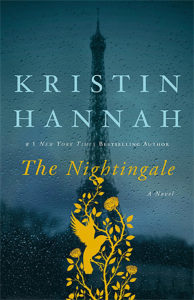 The Nightingale by Kristin Hannah – ISBN 978-1447283072
The Nightingale by Kristin Hannah – ISBN 978-1447283072
The scene: France. Vianne and Isabelle are sisters, and while they’re close they couldn’t be more different. When war breaks out their relationship is tested to breaking point in often unbelievably horrific ways. It turns out there’s more than one way to resist the enemy, and bravery takes many different forms. This fabulous book reveals an era of terrible atrocities, but also a time when simple humanity and compassion rose far above them.
All The Light We Cannot See by Anthony Doerr
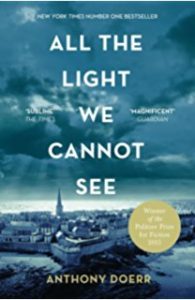 The awards say it all: A 2015 Pulitzer for fiction, finalist in the National Book Award, a New York Time bestseller, and winner of the Carnegie Medal for fiction. It’s widely recognized as a very beautiful yet incredibly ambitious book about a blind French girl and a German boy who struggle to survive when their very different paths cross in WW2 occupied France.
The awards say it all: A 2015 Pulitzer for fiction, finalist in the National Book Award, a New York Time bestseller, and winner of the Carnegie Medal for fiction. It’s widely recognized as a very beautiful yet incredibly ambitious book about a blind French girl and a German boy who struggle to survive when their very different paths cross in WW2 occupied France.
Summer of My German Solider by Bette Green
This story was first published in 1973, less than three decades after the Second World War ended, when it was still within living memory for millions and its effects were still being felt. The story is told by a twelve-year-old Jewish girl, Patty Bergen, who lives in Jenkinsville, Arkansas. When a German POW camp is built in town, she meets Anton whom she soon sees as a scared young man rather than the enemy. He understands her far better than her parents. As a book for children, it’s surprisingly hard-hitting. The fact that it’s still in print attests to its beauty.
Sarah’s Key by Tatiana De Rosnay
 When a book is made into a movie, you know it’s something special. Although I still like the book better, this one was made into a film in 2010, starring Kristin Scott Thomas. It’s 1942. Sarah is ten when she, her father and mother are arrested by the French police for being Jewish. Hidden by Sarah before the police arrive, her little brother escapes arrest. Roll time forward to 1960s Paris and US journalist Julia Jarmond is asked to write about the Vel’ d’Hiv’, the dark day the French police arrested thousands of Jewish people and sent them to the concentration camps. It turns out that two families are still haunted by guilt thanks to that terrible day, when dreadful secrets were buried along with the truth.
When a book is made into a movie, you know it’s something special. Although I still like the book better, this one was made into a film in 2010, starring Kristin Scott Thomas. It’s 1942. Sarah is ten when she, her father and mother are arrested by the French police for being Jewish. Hidden by Sarah before the police arrive, her little brother escapes arrest. Roll time forward to 1960s Paris and US journalist Julia Jarmond is asked to write about the Vel’ d’Hiv’, the dark day the French police arrested thousands of Jewish people and sent them to the concentration camps. It turns out that two families are still haunted by guilt thanks to that terrible day, when dreadful secrets were buried along with the truth.
Restless by William Boyd
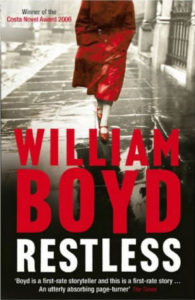 This is an unputdownable story that connects two related stories, one set in the present, the other during World War Two. It’s a layered, multi-faceted story that includes a mother-daughter relationship, espionage, and romance, all in one — my favorite kind of novel, actually. The story in the present features Ruth, a single mother who struggles to make sense of her own life. However, she becomes deeply involved with her mother’s past during the war and discovers everything she ever knew about her mother was a carefully constructed lie. Sally Gilmartin is a respectable English widow living in picturesque Cotswold village; Eva Delectorskaya was a rigorously trained World War II spy, a woman who carried fake passports and retreated to secret safe houses, a woman taught to lie and deceive, and above all, to never trust anyone. When someone tries to kill Sally, she reveals her true identity to her daughter, who then sets off to find the man who recruited her mother and may be looking to assassinate her.
This is an unputdownable story that connects two related stories, one set in the present, the other during World War Two. It’s a layered, multi-faceted story that includes a mother-daughter relationship, espionage, and romance, all in one — my favorite kind of novel, actually. The story in the present features Ruth, a single mother who struggles to make sense of her own life. However, she becomes deeply involved with her mother’s past during the war and discovers everything she ever knew about her mother was a carefully constructed lie. Sally Gilmartin is a respectable English widow living in picturesque Cotswold village; Eva Delectorskaya was a rigorously trained World War II spy, a woman who carried fake passports and retreated to secret safe houses, a woman taught to lie and deceive, and above all, to never trust anyone. When someone tries to kill Sally, she reveals her true identity to her daughter, who then sets off to find the man who recruited her mother and may be looking to assassinate her.
UnBroken by Laura Hillenbrand
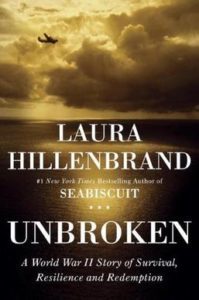 The only non-fiction book to make my list, ‘Moving’ doesn’t do Unbroken justice. It’s unforgettable, telling the extraordinary story of Louis Zamperini, a defiant teenager whose athletic talents took him to the Berlin Olympics. When World War II began he signed on as an airman, ending up crashing into the Pacific in 1943. He survived the crash but was faced with an epic journey across thousands of miles of ocean on a flimsy life raft, driven to the limits of endurance in an effort to reach home. Will this extraordinary character make it?
The only non-fiction book to make my list, ‘Moving’ doesn’t do Unbroken justice. It’s unforgettable, telling the extraordinary story of Louis Zamperini, a defiant teenager whose athletic talents took him to the Berlin Olympics. When World War II began he signed on as an airman, ending up crashing into the Pacific in 1943. He survived the crash but was faced with an epic journey across thousands of miles of ocean on a flimsy life raft, driven to the limits of endurance in an effort to reach home. Will this extraordinary character make it?
Philip Kerr’s Bernie Gunther series
The Bernie Gunther series of historical thrillers is set in Germany and elsewhere during the 1930s, the Second World War and the Cold War. Kerr’s sardonic, hard-living, heavy-drinking and smoking fictional detective is a true Berliner, a man who served 11 years as a homicide detective with the city’s criminal police. Now a private detective at the Adlon Hotel, he’s admirably qualified to deal with every imaginable type of deviance, corruption, and violence. He’s fearless and amoral. But that’s what war experiences will do to a man.
Cara Black’s Murder in the Marais
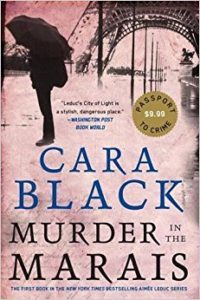 When French-American detective Aimée Leduc, created and nurtured by my friend Cara Black, meets an elderly Jewish man with a top-secret decoding job he’s arranging for a woman who attends his synagogue, Aimée bites off a lot more than she can chew. When she tries to deliver the results of her investigations to her client’s house in the Marais district of Paris, she finds the woman strangled to death with a swastika carved into her forehead. Will she solve the horrific murder, tangled in a lethal web of secrets and war crimes?
When French-American detective Aimée Leduc, created and nurtured by my friend Cara Black, meets an elderly Jewish man with a top-secret decoding job he’s arranging for a woman who attends his synagogue, Aimée bites off a lot more than she can chew. When she tries to deliver the results of her investigations to her client’s house in the Marais district of Paris, she finds the woman strangled to death with a swastika carved into her forehead. Will she solve the horrific murder, tangled in a lethal web of secrets and war crimes?
WW2 novels by Alan Furst
Alan Furst is the American author of a bunch of first class historical spy novels: A Hero of France, The Spies of Warsaw (recently televised as a series in the UK), Midnight in Europe, Mission to Paris and more. The majority of his books written since 1988 are set just before the start of WW2, and he’s respected worldwide for his extraordinary portrayals of Eastern Europe from 1933 to 1944.I especially liked Midnight in Europe.
In Fairleigh Field by Rhys Bowen
 Last but not least, I have to mention my friend Rhys Bowen’s stand-alone novel In Fairleigh Field. It’s riveting. When a soldier falls to his death thanks to a parachute that doesn’t open, the MI5 operative and family friend of Lord Westerham, Ben Cresswell, is secretly tasked with finding out whether the dead man was a Nazi spy. As he follows a complex trail of spies and traitors, he discovers a terrible, history-changing hidden agenda. Can he and Lord W’s daughter Pamela stop the plot before England falls?
Last but not least, I have to mention my friend Rhys Bowen’s stand-alone novel In Fairleigh Field. It’s riveting. When a soldier falls to his death thanks to a parachute that doesn’t open, the MI5 operative and family friend of Lord Westerham, Ben Cresswell, is secretly tasked with finding out whether the dead man was a Nazi spy. As he follows a complex trail of spies and traitors, he discovers a terrible, history-changing hidden agenda. Can he and Lord W’s daughter Pamela stop the plot before England falls?
The post My Favorite WW2 Novels appeared first on .
February 27, 2017
The Manhattan Project – The Early Years

The Manhattan Project, featured in War, Spies, and Bobby Sox, was a key WW2 research and development project tasked with creating the world’s first nuclear weapon. Led by the US and supported by the United Kingdom and Canada, it ran between 1942 and 1946, directed by Major General Leslie Groves of the U.S. Army Corps of Engineers. Nuclear physicist J. Robert Oppenheimer directed the New Mexico lab, Los Alamos, which actually designed the bombs.
But prior to the move out to Los Alamos, before it was officially called the Manhattan Project, several different universities worked on a critical task that had to be achieved before a bomb could be produced. And the University of Chicago played a starring role.
Chicago’s Met Lab
The Metallurgical Laboratory at the University of Chicago, AKA the Met Lab, was one of several university physics departments across the country working to create a sustained nuclear reaction. Their job was to strip the nucleus of a uranium atom so that it would collide (and strip) another atom, and release a large amount of energy in the process. The process needed to be self-perpetuating, but it also had to be controlled. It was called fission.
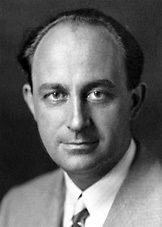 1939 saw a team at Columbia University – including Enrico Fermi, who directed the experiments, Leo Szilard, Walter Zinn, and Herbert Anderson – busy working on the fission process. Another team in California was also involved, as was the University of Chicago, under the leadership of Arthur Compton, Nobel Prize winner and Professor of Physics. Determined to bring about a self-sustaining nuclear reaction, Compton managed to persuade Fermi to move to the Met Lab in early 1942.
1939 saw a team at Columbia University – including Enrico Fermi, who directed the experiments, Leo Szilard, Walter Zinn, and Herbert Anderson – busy working on the fission process. Another team in California was also involved, as was the University of Chicago, under the leadership of Arthur Compton, Nobel Prize winner and Professor of Physics. Determined to bring about a self-sustaining nuclear reaction, Compton managed to persuade Fermi to move to the Met Lab in early 1942.
The Pile
The structure in which they conducted experiments was called the “pile,” because that’s what it looked like to the scientists. It was constructed on an old squash court under Stagg

Football Field, right in the center of the University campus. After months of experiments, the Chicago Pile went critical on December 2, 1942. It emitted a thermal output of 0.5 watts, a fraction of the eventual 200 watts it ultimately reached. Fermi’s design was a success, and eventually inspired the B Reactor at Hanford, the first full-scale reactor, as well as the X-10 Graphite Reactor at Oak Ridge, Tennessee.
Ryerson Lab and Eckhart Hall were also part of the Met Lab complex. James Schoke worked at Ryerson developing ways to detect and measure radiation, and both labs were hives of enthusiastic activity. As Fermi himself said, “The morale of the scientists could almost be plotted in a graph by counting the number of lights burning after dinner in the offices at Eckhart Hall.”
The End of the Beginning
Compton was keen to carry on building experimental piles and a chemical separation plant on the U of Chicago campus, but safety concerns led to Red Gate Woods, code-named Argonne, and the Oak Ridge site being chosen instead. At Argonne Forest, Chicago Pile-2 and Pile-3 were constructed, but the site was demolished after the war in favor of a bigger site in DuPage County. Argonne National Laboratory became the nation’s first ever national science and engineering lab.
 Ultimately, the entire project moved to Los Alamos, but the West Stands in Stagg Field weren’t demolished until 1957, replaced, in part, by the Regenstein Library. But plaques still commemorate Chicago Pile-1. And a huge bronze sculpture by mid-century British sculptor Henry Moore was installed in 1967 to mark the spot where CP-1 went critical.
Ultimately, the entire project moved to Los Alamos, but the West Stands in Stagg Field weren’t demolished until 1957, replaced, in part, by the Regenstein Library. But plaques still commemorate Chicago Pile-1. And a huge bronze sculpture by mid-century British sculptor Henry Moore was installed in 1967 to mark the spot where CP-1 went critical.
Today nuclear weapons are at the heart of the western world’s defenses. We’re just as terrified of them as ever, and the world’s non-proliferation agreement remains at risk. And yet no country with nuclear weapons seems prepared to decommission them. In fact, in 1947, the academic journal Bulletin of the Atomic Scientist created the famous Doomsday Clock, which measures how close the planet is to nuclear war. Midnight marks 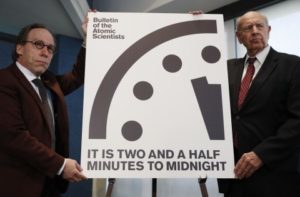 the apocalypse, and the clock was originally set at seven minutes to twelve. Now, thanks to changing international politics, new technology, climate change, amongst other factors, the clock is set at just two and a half minutes to midnight. With Mr. Trump at the helm, it might have to be re-set again.
the apocalypse, and the clock was originally set at seven minutes to twelve. Now, thanks to changing international politics, new technology, climate change, amongst other factors, the clock is set at just two and a half minutes to midnight. With Mr. Trump at the helm, it might have to be re-set again.
The post The Manhattan Project – The Early Years appeared first on .
February 18, 2017
(Mostly) Unsuccessful WW2 Espionage on the Home Front
 Europe, the main theater of World War Two, was thousands of miles across the Atlantic. But Nazi intelligence inserted German operatives into American cities and tried to convert German-Americans to Nazism well before the war broke out. During the war itself America saw plenty of espionage incidents and there was probably much more spy activity going on that the public was never told about. Here are just three of at least ten known incidents that took place during the war years.
Europe, the main theater of World War Two, was thousands of miles across the Atlantic. But Nazi intelligence inserted German operatives into American cities and tried to convert German-Americans to Nazism well before the war broke out. During the war itself America saw plenty of espionage incidents and there was probably much more spy activity going on that the public was never told about. Here are just three of at least ten known incidents that took place during the war years.
John Dasch’s Long Island Landing
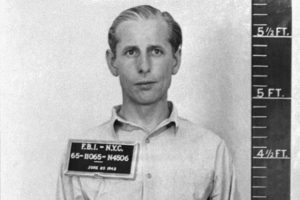 In June 1942 a German U-boat delivered a group of saboteurs to the Long Island coast, led by George John Dasch. Their mission was to spend two years performing acts of violence, blowing up bridges, railways, and factories in New York City and across the East Coast in an operation dubbed ‘Pastorius’. The men were not experienced in espionage or sabotage and Hitler’s advisors were doubtful of success.
In June 1942 a German U-boat delivered a group of saboteurs to the Long Island coast, led by George John Dasch. Their mission was to spend two years performing acts of violence, blowing up bridges, railways, and factories in New York City and across the East Coast in an operation dubbed ‘Pastorius’. The men were not experienced in espionage or sabotage and Hitler’s advisors were doubtful of success.
Luckily Hitler’s fears were realized. The submarine got stuck on a sandbar off Amagansett and local Coast Guard officer John Cullen discovered them. Dasch unsuccessfully tried to bribe Cullen, who reported the incident, and the spies’ explosives, German uniforms, and German cigarettes were later dug up on the beach.
By that time Dasch and his group had reached New York City, but Dasch got spooked and turned in his fellow spies, as well as himself. He wasn’t executed like the rest but after three decades in jail, he was finally deported back to West Germany in 1948.
Guenther Rumrich’s famous passport scam
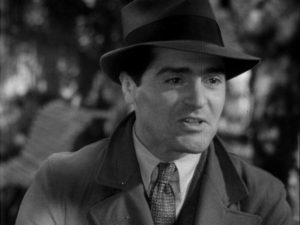 Guenter Rumrich was born in my adopted home town, Chicago but was raised in Germany. Returning to the States in the late 1920s, he served in the US Medical Corps in Panama before deserting in 1936. He became suspect thanks to a Scottish woman, Jessie Jordan, who was already under surveillance by Britain’s MI-5 as a potential mail drop, passing letters between Nazi spies in the UK and US. When ‘Mr. Crown’, one of her contacts, turned out to be a code name for Rumrich, he was immediately put under surveillance.
Guenter Rumrich was born in my adopted home town, Chicago but was raised in Germany. Returning to the States in the late 1920s, he served in the US Medical Corps in Panama before deserting in 1936. He became suspect thanks to a Scottish woman, Jessie Jordan, who was already under surveillance by Britain’s MI-5 as a potential mail drop, passing letters between Nazi spies in the UK and US. When ‘Mr. Crown’, one of her contacts, turned out to be a code name for Rumrich, he was immediately put under surveillance.
In early 1938 Rumrich phoned the NYC Passport Office pretending to be the Undersecretary of State, asking for 35 blank passports. The clerk was suspicious and reported the call to the authorities. Rumrich was quickly arrested and became notorious as America’s first major pre-war spy. He gave up his fellow spies, who were also arrested, and was given a two year jail sentence as a reward for co-operating. The case, however, alerted the nation about America’s vulnerability to espionage and the government acted fast to close a bunch of loopholes.
Erich Gimpel and William Colepaugh’s Operation Magpie
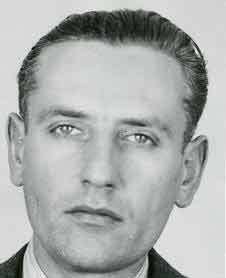 Late 1944 saw two German agents landing in America tasked with gathering intelligence on the US military and delaying the development of the atomic bomb. Erich Gimpel and William Colepaugh were keen but inexperienced in spycraft. A U-boat dropped them off at Bar Harbor in Maine, wearing completely unsuitable clothing for the time of year and carrying conspicuously expensive luggage packed with fake IDs, firearms, cameras, cash, and diamonds.
Late 1944 saw two German agents landing in America tasked with gathering intelligence on the US military and delaying the development of the atomic bomb. Erich Gimpel and William Colepaugh were keen but inexperienced in spycraft. A U-boat dropped them off at Bar Harbor in Maine, wearing completely unsuitable clothing for the time of year and carrying conspicuously expensive luggage packed with fake IDs, firearms, cameras, cash, and diamonds.
Arriving in New York City by train, the pair devolved into chaos. Colepaugh, an unstable alcoholic, immediately went on a bender, to the disgust of his partner in crime, and spent large amounts of the money they’d set aside for expenses. Colepaugh and a female companion he’d found along the way, eventually ran off with the remaining cash – more than $40,000 – and after a monster of a Christmas binge gave himself up to the FBI. Neither he nor Gimpel had done any actual spying, and like so many of his cowardly predecessors Colepaugh spilled the beans, telling the authorities everything he knew.
Both men were sentenced to death, but the war ended before they could be executed and they ended up in jail. Gimpel was released in 1955 and returned to West Germany, Colepaugh qualified for parole in 1960, and moved to Pennsylvania.
Other WW2 German spies on US soil
German Abwehr agent Lilly Stein recruited agents in New York, posing as a dress shop owner. Nazi spy Hermann W. Lang worked in the Carl L. Norden Corp. factory and spied on the progress of the company’s innovative new bombsight. The mission of the Ponte Vedra foursome was simple: commit acts of sabotage and terrorism on Jewish owned shops and destroy New York City’s water system. And maybe most famously, Fritz Duquesne and his 33-strong Spy Ring were all arrested in what became the biggest round up of foreign spies in the US, thanks to Double Agent William Sebold who worked with the FBI to expose them. The Duquesne spies were all convicted, but William Sebold himself disappeared, and his fate remains a mystery. Cary Grant starred in a 1945 film, “The House on 92nd Street,” which was based on the Spy Ring.
Happily, most of these German spies were inexperienced, several were unstable, a couple may actually have been mentally ill, and none of the failed plots made much of an impact on the allies’ progress. If they’d been better suited to the job, who knows what might have happened?
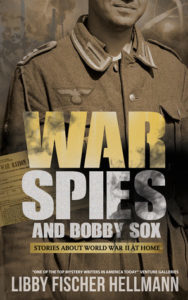
You can find more espionage stories (fiction this time) in War, Spies, and Bobby Sox: Stories about World War Two at Home, which will be released Feb. 28th.
The post (Mostly) Unsuccessful WW2 Espionage on the Home Front appeared first on .
February 9, 2017
The Winston Churchill War Rooms
I spent a week across the pond over the holidays, and one of my must-see visits was to the Churchill War Rooms.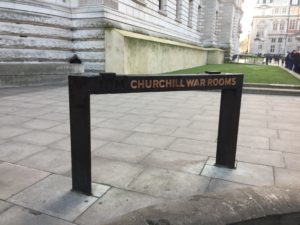
What are they? Glad you asked.
Follow me back in time to World War Two. Britain was facing dark days, embroiled in a conflict that would kill millions of civilians and soldiers and ultimately change the wo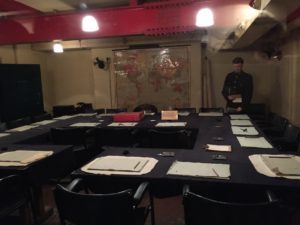 rld forever. During 1938, as the clouds of war gathered, the basement of a building in Whitehall became the site of the Cabinet War Rooms. When the war actually began, the core of the British government – led by Sir Winston Churchill himself— holed up in this secret underground bunker and the rooms fast became the inner sanctum of the British government. Churchill himself first visited the war rooms on 10th May 1940, famously announcing that, “This is the room from which I will run the war.” As it turns out, it’s also where he finally won it.
rld forever. During 1938, as the clouds of war gathered, the basement of a building in Whitehall became the site of the Cabinet War Rooms. When the war actually began, the core of the British government – led by Sir Winston Churchill himself— holed up in this secret underground bunker and the rooms fast became the inner sanctum of the British government. Churchill himself first visited the war rooms on 10th May 1940, famously announcing that, “This is the room from which I will run the war.” As it turns out, it’s also where he finally won it.
Churchill sat in the chair closest to the camera, and apparently the arms of the chair feature deep scratches in the wood, dug by his fingernails as he battled the constant tension and fear.
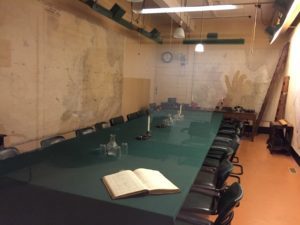
The Cabinet War Rooms were closed shortly after the Japanese surrendered in August 1945. You can imagine how very relieved and thankful the Prime Minister and his government were to simply lock the door of the place behind them when the war finally came to an end. Indeed, the complex sat undisturbed for three years, until 1948, when Parliament decided it should be preserved as a historic site. Very few people knew about it and fewer still visited until decades later, in the late 1970s, when the Imperial War Museum finally began its restoration work. They opened in 2003, and in 2005 the Imperial War Museum added the world’s only major museum dedicated to Sir Winston Churchill adjacent to the bunker.
The entire block of rooms were predicated on the supposition that at some point, the top military and political figures of Britain might have to live there indefinitely. As it turned out, Churchill only slept there for four nights, and he demanded that his wife, Clementine, stay there too. Here are their bedrooms. Notice the telephone on his desk in the background, so he could be in touch with anyone anytime.
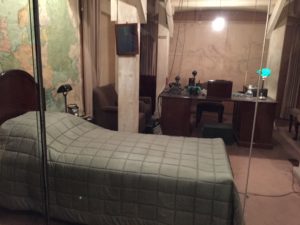
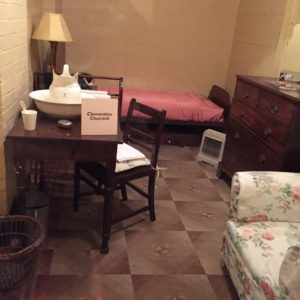
And here is the “secure” telephone set-up he used when he called FDR.
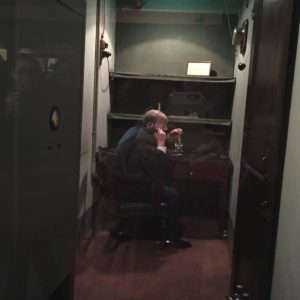
Here is the typing pool room and the telegraph room, all underground.
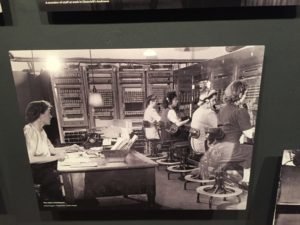
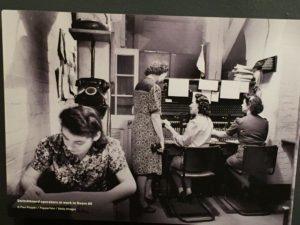
And this was the kitchen where his meals were prepared (Churchill was a gourmand, of course)

In the museum you can find all sorts of Chuchillian artifacts, including war posters and other propaganda.
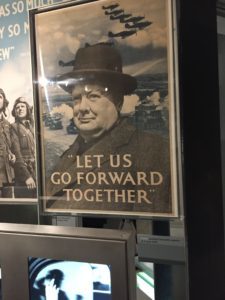

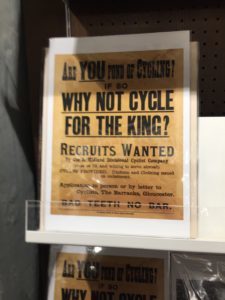
The museum also has —writers will enjoy this—the offer from his publisher for his first book! 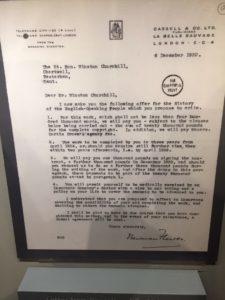
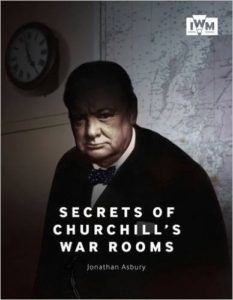
If you want to see more of the War Rooms but can’t make it across the pond, there’s a book just out that lets you do exactly that, revealing places that visitors never get to see. It’s called Secrets of Churchill’s War Rooms, out in hardcover, published by the University of Chicago Press, available for $45 and written by Jonathan Asbury.
The post The Winston Churchill War Rooms appeared first on .
February 7, 2017
Still Star-Struck After All These Years
This is a reprint of a blogpost originally published on The Lipstick Chronicles, which is sadly gone now. Given the day, I thought you’d appreciate it.
One of the nice things about being an author is that people don’t usually recognize you when you break out of the cage and go outside. Which means I can wear sweats, my hair can be a mess, my socks mismatched, and no one cares (except my Mother). I like that anonymity. In fact, I crave it. I think part of it comes from the fact that I grew up in Washington, DC, where gossiping about the neighbors meant you were talking politics. Seeing a boring senator or congressman, even a President, wasn’t a big deal, especially when I used to roll Easter eggs on the White House lawn with Mamie.
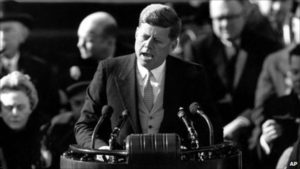 Kennedy changed all that. I was only 10 when he was elected, but even I knew something was different. He was handsome and witty, his wife was gorgeous and sophisticated. They both had IT. Charisma. I often think that was the beginning of DC’s metamorphosis from a sleepy southern swamp to something more polished and metropolitan.
Kennedy changed all that. I was only 10 when he was elected, but even I knew something was different. He was handsome and witty, his wife was gorgeous and sophisticated. They both had IT. Charisma. I often think that was the beginning of DC’s metamorphosis from a sleepy southern swamp to something more polished and metropolitan.
The Kennedy charisma was addictive, and I inhaled it. And over the years looked for more. As a result, though I don’t want to be one, I’m just as star-struck as the next gal. There’s something about being close to the glamour, the fame, the sparkle and glitz that’s seductive. I want to touch it. See if it’s real. There was even a trending topic about it on Twitter a few months ago — I can’t remember the exact name, but it was about people’s anecdotes when brushing up against celebrities.
So, though it has nothing to do with my upcoming book, I wanted to share some of my brushes with the stars.
 I was 14 when the Beatles came to DC for a concert. I discovered they were staying at the Shoreham Hotel, which was only one block from my house. Really. On top of that, it was a snowy February day, and school was dismissed early. I rushed to the Shoreham with a friend, who just happened to know someone who lived on the hotel’s seventh floor. Along with 100 other screaming girls, we watched the Beatles climb out of their limo and into the elevator. Then we hot-footed it to another set of elevators up to the seventh floor. Imagine our shock when we ran into a cop in the hall! That clinched it. We knew the Beatles were staying on the seventh floor. While my friend explained to the cop that we really were visiting her friend, I ran down the hall to the first set of elevators. Sure enough, a minute later the Fab Four emerged. I shoved a piece of paper at George Harrison, and he said five words that I have remembered for the rest of my life: “Do you have a pencil?”
I was 14 when the Beatles came to DC for a concert. I discovered they were staying at the Shoreham Hotel, which was only one block from my house. Really. On top of that, it was a snowy February day, and school was dismissed early. I rushed to the Shoreham with a friend, who just happened to know someone who lived on the hotel’s seventh floor. Along with 100 other screaming girls, we watched the Beatles climb out of their limo and into the elevator. Then we hot-footed it to another set of elevators up to the seventh floor. Imagine our shock when we ran into a cop in the hall! That clinched it. We knew the Beatles were staying on the seventh floor. While my friend explained to the cop that we really were visiting her friend, I ran down the hall to the first set of elevators. Sure enough, a minute later the Fab Four emerged. I shoved a piece of paper at George Harrison, and he said five words that I have remembered for the rest of my life: “Do you have a pencil?”
 I was working in my first job at WRC-TV in DC the summer of ’69. Peter Fonda and Dennis Hopper had just released Easy Rider, and Jack Nicholson (“Nick-nick”) came to the radio station to do an interview. We were in the middle of producing a local documentary about “Washington’s youth,” so I ran down to the basement where he was interviewing and asked if he’d do an interview for us. He said sure, and that night we went to a disco with film crews, lights, etc. During the course of the evening, he asked if I’d go back to his hotel room with him. I said five words I may regret for the rest of my life: “Sorry, I have a curfew.”
I was working in my first job at WRC-TV in DC the summer of ’69. Peter Fonda and Dennis Hopper had just released Easy Rider, and Jack Nicholson (“Nick-nick”) came to the radio station to do an interview. We were in the middle of producing a local documentary about “Washington’s youth,” so I ran down to the basement where he was interviewing and asked if he’d do an interview for us. He said sure, and that night we went to a disco with film crews, lights, etc. During the course of the evening, he asked if I’d go back to his hotel room with him. I said five words I may regret for the rest of my life: “Sorry, I have a curfew.”
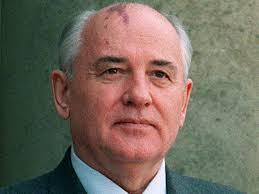 Years later I was producing a fundraising video for Hugh O’Brian –the original TV Wyatt Earp. He had launched a youth foundation that is still active today. If you know Hugh, you know he doesn’t take no for an answer, and by some miracle, he’d invited Mikhail Gorbachov to the US for a fundraising banquet. I got to shoot video of the event. OK, yes he’s a politician, but, like Kennedy, Gorbachov had charisma. I confess a little “thrill went up my leg” when I shook his hand.
Years later I was producing a fundraising video for Hugh O’Brian –the original TV Wyatt Earp. He had launched a youth foundation that is still active today. If you know Hugh, you know he doesn’t take no for an answer, and by some miracle, he’d invited Mikhail Gorbachov to the US for a fundraising banquet. I got to shoot video of the event. OK, yes he’s a politician, but, like Kennedy, Gorbachov had charisma. I confess a little “thrill went up my leg” when I shook his hand.
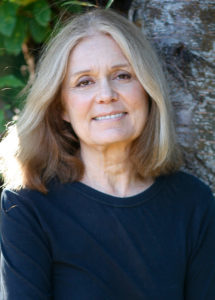
SteinemGloria_hi res
Finally a few years ago, I went to a Women’s Business networking conference. I got there about a half hour early and walked into the luncheon hall to read the paper. There, sitting in a corner all by herself, looking incredibly beautiful, was Gloria Steinem. I sucked in a breath. I really wanted to talk to her, but I didn’t want to invade her privacy. Happily, she looked up, smiled, so I screwed up my courage and went over. We ended up chatting for about 10 minutes. I was gobsmacked.
Interesting how whom we admire changes over time. What about you? What brushes with celebrity do you hold dear? Do any seem silly now?
The post Still Star-Struck After All These Years appeared first on .
January 29, 2017
Nazis in America? Meet The German American Bund

My upcoming WW2 book, War, Spies and Bobby Sox, includes three stories about World War Two on the homefront. Obviously, Hitler’s Germany never actually invaded our shores or blitzed us as they did our UK cousins. But, in fact, Nazism was alive and well in the US during the 1930s, just as it was in Europe. Here’s the story of the German American Bund, which is a factor in all three of my stories.
Roosevelt and his administration detested fascism. But in the pre-war years, and stretching beyond, the US was home to an extensive Nazi counter-culture loyal to Hitler and his henchmen. The German-American Bund, based in New York, evolved from several pro-Nazi groups in the 1930s. The Bund was led by Fritz Kuhn and hit a peak in popularity between 1936 and 1939. Kuhn reckoned he had at least two hundred thousand followers. The FBI were more circumspect, estimating fewer than ten thousand, and a piece of research by the American Legion identified just twenty five thousand.
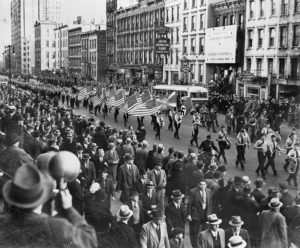 However many or few Fascists there were running around the USA, enough Bund members existed to set up a network of businesses, publications, training camps, Hitler Youth organizations and SS-like groups. Twenty thousand of the German American Bund took to the streets of New York city in late 1939 in a parade, testament to the power of free speech. However, Kuhn was eventually sent to jail for embezzlement, having spent Bund funds to finance his love affairs, and the organization subsequently fell apart.
However many or few Fascists there were running around the USA, enough Bund members existed to set up a network of businesses, publications, training camps, Hitler Youth organizations and SS-like groups. Twenty thousand of the German American Bund took to the streets of New York city in late 1939 in a parade, testament to the power of free speech. However, Kuhn was eventually sent to jail for embezzlement, having spent Bund funds to finance his love affairs, and the organization subsequently fell apart.
Did people protest against the German American Bund? Absolutely. Plenty of Jewish organizations boycotted German products, and some prominent members of the Jewish underworld used violence to break up Bund meetings, including Meyer Lansky, Bugsy Siegel, Mickey Cohen and Jack Ruby. (Yes, THAT Jack Ruby).
At one stage, rumor had it that Henry Ford was a Bund supporter, especially since Kuhn was a Ford employee. Ford apparently turned up at Grand Central station to see Kuhn off to Sing Sing but never provided a good reason why. Hitler adored Ford’s anti-Semitic manifesto, The International Jew. He mentioned the magnate by name in his book, Mein Kampf, and apparently had a photo of Ford hanging in his office. July 1938 saw Ford being awarded the Grand Cross of the German Eagle, an ‘honor’ he refused to reject.
Just before the war Charles Lindbergh visited Germany to inspect the Third Reich’s air capabilities, hooking up with a bunch of Nazi officials at the same time. He was given a Grand Cross of the German Eagle of his own by Göring. By 1940 Lindbergh had become a prominent voice in the America First movement, determined to keep the US out of the war. In fall 1941 Lindbergh spoke publicly to denounce Roosevelt and America’s Jews for pushing the nation into the war in Europe.
They weren’t the only sympathizers. The early 1930s saw ex-journalist William Dudley Pelley creating his Silver Legion of America, AKA the Silver Shirts, which eventually attracted 15,000 members. He ran for president in 1936, but the movement didn’t last – by 1938 it was dead in the water. Then there was the Friends of Progress over in California, which held meetings and rallies in the LA area. And there was also Joseph Kenney, Ambassador to the UK for Roosevelt, and father of JFK, whose pro-Hitler feelings were quite well known.
Even after the Third Reich finally crashed and burned, a few US citizens held onto their pro-Nazi ideas, including, famously, George Lincoln Rockwell. After WW2 he became embroiled with anti-Semitic extremists and eventually created the American Nazi Party. He ran for president in 1964 as a write-in candidate, and carried on supporting the fascist cause throughout the 1960s. Rockwell was assassinated by one of his own followers in 1967, finally signaling the end of the German American Bund.
We live in a country where free speech is cherished. We might not always like the fact that people have that right. But consider this: Is it better to suppress unpleasant views and risk them going underground, or let people say what they wish openly, revealing their madness and letting them hang themselves?
For an excellent history of the Bund, I highly recommend Arnie Bernstein’s Swastika Nation.
 War, Spies, and Bobby Sox will be released Feb.28, but you can preorder it for just 99¢ at Amazon (both print and ebook), iBooks, Nook, and Kobo.
War, Spies, and Bobby Sox will be released Feb.28, but you can preorder it for just 99¢ at Amazon (both print and ebook), iBooks, Nook, and Kobo.
The post Nazis in America? Meet The German American Bund appeared first on .
January 20, 2017
World War Two: German POWs Incarcerated in the US
 My latest book, War, Spies, and Bobby Sox, comes out February 28th. (but it’s on preorder now… see below) It’s a trio of stories set during World War Two. One of the stories, P.O.W., took me down a rabbit hole of fascinating research into the era and our involvement in the conflict. So of course, I had to write about it.
My latest book, War, Spies, and Bobby Sox, comes out February 28th. (but it’s on preorder now… see below) It’s a trio of stories set during World War Two. One of the stories, P.O.W., took me down a rabbit hole of fascinating research into the era and our involvement in the conflict. So of course, I had to write about it.
Even if you know a great deal about the dark days when the whole of Europe and beyond was under the terrifying shadow of the Nazis, you may not know about this situation. I didn’t. The fact is that during 1943-1945 nearly half a million of German (and some Italian) WW2 POWs were imprisoned right here at home in the United States.
A half a million WW2 prisoners kept in the US
By 1943, the US was succeeding in the fight to vanquish the Axis, especially in North Africa. Rommel’s Army had been defeated, and many of the Wehrmacht soldiers were captured by the Americans. That presented a problem: where to incarcerate them? There weren’t adequate facilities in Europe, and transportation across Europe was problematic. The Army, which had responsibility for the POWs, decided to load them onto supply ships that had brought armaments and other equipment to Europe for the return journey to the US. Once the ships reached our shores, the prisoners were sent to camps all over the country. Only 4 states—Alaska, Nevada, North Dakota, and Vermont—did not house any POWs within their borders. For example, there were half a dozen camps in Illinois, and one of them-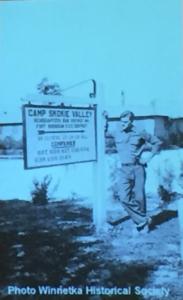 Skokie Valley– was less than five miles from my house!
Skokie Valley– was less than five miles from my house!
The camps were refurbished CCC camps left over from the Depression, hastily built barracks, even abandoned Girl Scout camps. All together over 700 home-grown Branch Camps housed more than 425,000 prisoners of war.
Curiously, most of the prisoners were quite pleased to be incarcerated here. The Army made sure to follow the terms of the Geneva Convention to the letter, treating foreign prisoners the way they hoped American POWs would be treated by Germany. According to the Smithsonian,
Life in the camps was a vast improvement for many of the POWs who had grown up in “cold water flats” in Germany, according to former Fort Robinson, Nebraska, POW Hans Waecker, 88, who returned to the United States after the war and is now a retired physician in Georgetown, Maine. “Our treatment was excellent. Many POWs complained about being POWs—no girlfriends, no contact with family. But the food was excellent and clothing adequate.” Such diversions as sports, theater, chess games and books made life behind barbed wire a sort of “golden cage,” one prisoner remarked.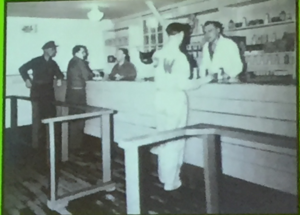
POWs didn’t just sit around. As you may know, there was an acute shortage of labor because so many American men were overseas, so POWs took their places at home, working on farms, in small factories, and even in manufacturing jobs. Take Nebraska, where around 12,000 prisoners of war were kept in camps. Many of them worked on the state’s roads. Others harvested hay or worked in the sugar beet fields. Some worked as hospital orderlies, Oddly, the prisoners included a lot of stone masons, who got involved with building structures for the locals. One man remembers them building a beautiful concrete garage which is, apparently, still standing.
In Northern Illinois, most of the prisoners worked on farms, and there are countless stories of men interacting well with Americans. Once the local people’s understandable worries had been put to rest – things like security and safety – they discovered that most Germans had no time for the Nazi Party and were grateful to be out of the war. In fact, experts believed less than 10% of them men were hard-core Nazi supporters. Add to that the fact that plenty of US citizens emigrated from Europe, including Germany, and you can understand why cordial relationships soon developed, even strong friendships and – ultimately, when peace came – love and marriage.
But there are always a few disgruntled personalities in every group, and there were cases of ‘true believers’ of the Nazi Party alongside the more tolerant Wehrmacht soldiers. This was a conflict no one anticipated, and in one or two instances, the actual murder of a German POW by an SS soldier occurred. The SS thought the soldiers were spying for the Americans. (Btw, you can imagine where this took me in the fictional part of the story). Even so, less than 1% made an attempt to escape, just 2,222 men. Most were caught almost immediately.
After the war ended some of the ex-prisoners returned to the States. A British friend tells me that an Italian POW held in North Yorkshire never left, staying put after the war and marrying a local girl. It happened on our side of the Atlantic too, contributing to the massive cultural melting pot that is the USA. According to history.net, one escaped German POW surrendered in 1985 so he could claim American citizenship and live legally in the US.
It’s curious… the fact that German POWs were scattered among Americans was not a secret, but it wasn’t broadcast either. To this day, thus, many Americans have no idea that over half a million Germans were here during the war.
As I said, I wrote about all of that —and more—in War, Spies and Bobby Sox, which is available for preorder now for only 99¢!* But buy it now. As of February 28, the price goes up to $4.99.
Enjoy!
(Photos by James Meierhoff
University of Illinois at Chicago
“Chicago’s German POW Camps”)
*While the primary link goes to Amazon (both print and ebook), you can also preorder it on iBooks, Nook, and Kobo.
The post World War Two: German POWs Incarcerated in the US appeared first on .



